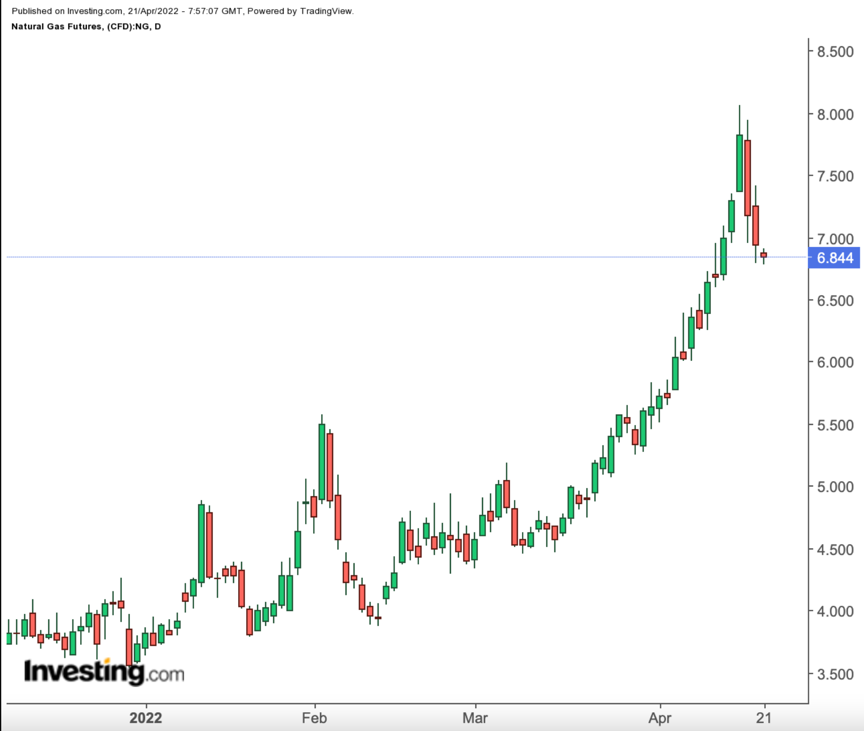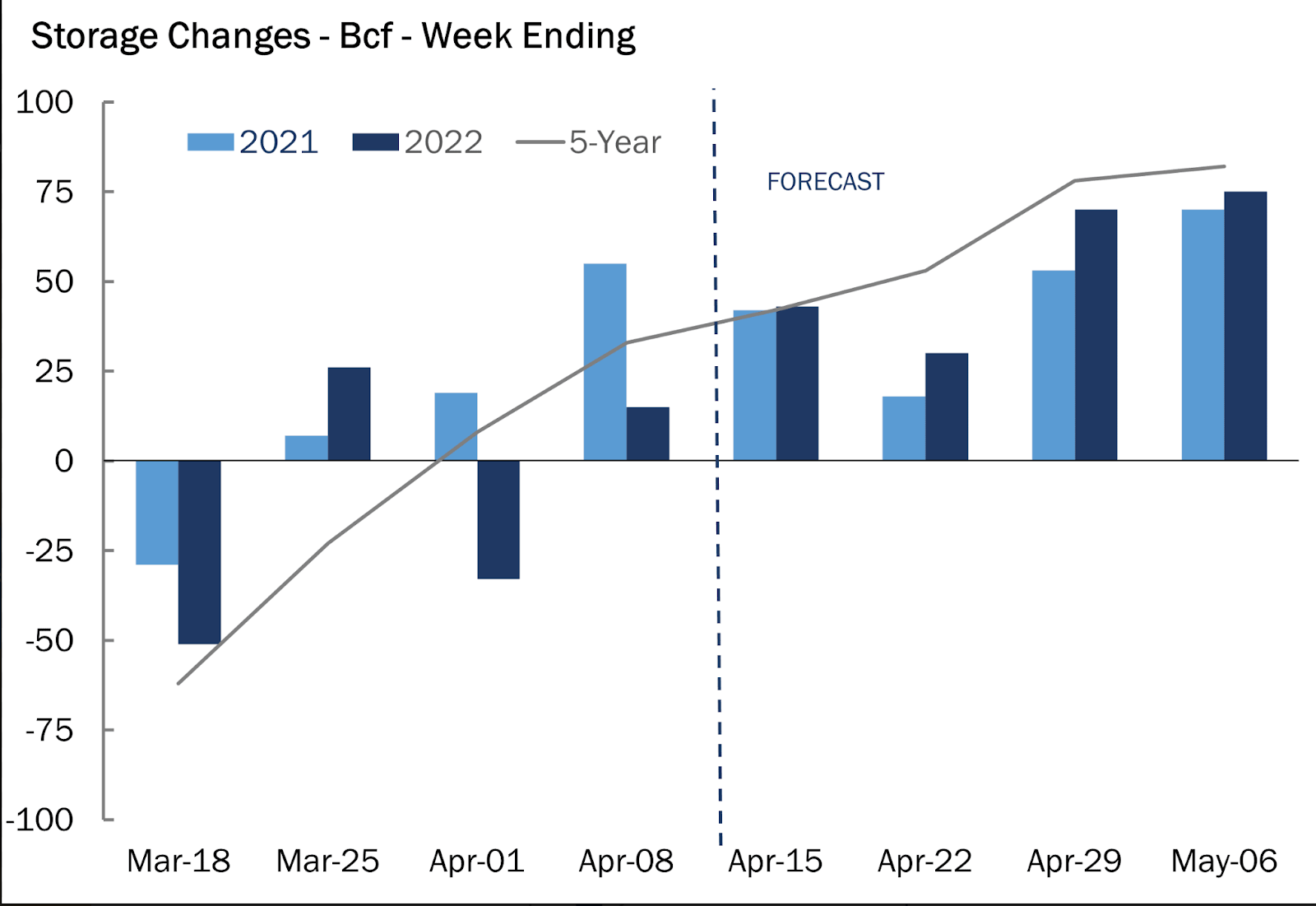A sudden reversal in natural gas, after the epic rally of the past five weeks, has the trade wondering if Monday’s $8 high may be the peak for now. 
While it’s unclear how much more the bears can win from the market’s flip, two things are quite clear: the need for indoor heating hasn’t gone away despite the advent of mid-spring, and promises of higher production could take longer than expected to materialize.
“There still remains much upside risk in the current market,” Houston-based gas markets consultancy Gelber & Associates said in a note to its clients on Wednesday.
One reason is that storage injections forecast through April are unlikely to be anywhere near five-year averages, leaving the deficit between the 2022 and 2017-2021 levels gaping as the month progresses.
This dynamic alone will be “placing the market in an environment where the prospect of additional tightness could allow prices to reclaim territory lost,” Gelber & Associates wrote in Wednesday’s note.
The firm’s analysts weren’t the only ones with such an opinion.
Bespoke Weather Services said in comments carried by naturalgasintel.com that this week’s market flip was ostensibly the product of “traders with long positions (who) took profits, which allowed for the pullback.”
“Our best guess remains that the recent selloff was ‘a much needed breather,'” Bespoke said, adding that expectations of robust production growth later in the year through 2023 needed more empirical studies.
“Modeled predictions are nice, but until we see those production gains show up, the risk remains skewed toward higher prices later this year,” it said, adding that “an ultimate move back above $8 is “still very much in play.”
Sunil Kumar Dixit, technical strategist at skcharting.com, says his natural gas charts concur with this.
“The daily NG chart clearly indicates that stochastics and the Relative Strength Indicator have managed to shed their overbought conditions and gas is done with the lows for the short term,” Dixit said.
“This means prices are very close to support areas of $6.688 and $6.262, which are the 38.2% and 50% Fibonacci retracement levels measured from the recent $4.459 low and recent peak of $8.065."
Dixit added that on the higher side, “bulls need to take the prices well above $7.214, which is a 23.6% Fibonacci level, for resuming upward momentum to test the high of 8.065 again.”
On that notion, gas futures on New York’s Henry Hub remained at under $7 in Thursday’s Asian trading—heading for their first weekly loss, after a 55% gain over the five previous weeks—as traders braced for the weekly gas storage update from the US Energy Information Administration (EIA).

Source: Gelber & Associates
Analysts tracked by Investing.com believe that the EIA will report that utilities injected some 37 billion cubic feet (bcf) of gas into storage during the week ended Apr. 15, after burning whatever they needed from the week’s production to generate power and heating.
A 42 bcf injection was recorded in the same week of last year, as well as on the five-year average.
Total working gas in storage as of Apr. 8 stood at 1,397 bcf, which is 439 bcf below last year and 303 bcf below the five-year average.
Gelber & Associates estimated that nearly 27 bcf of last week’s consumption was directly attributed to weather-related demand despite the need for heating—on paper, at least—falling in each week of the so-called shoulder season between the end of winter and the start of summer.
The fact was that “weather forecast projections over the two-week period have continually strengthened during the last month; this has contributed to sentiment within the market of extreme tightness,” the firm’s analysts said.
With periods of cool weather continuing to play out across the country, hefty storage deficits are expected to hold relatively steady through early May, at least, naturalgasintel.com posited. This leaves a steep uphill climb for the market to replenish inventories during the summer when more gas will be needed—this time for cooling.
"If you look at the weather path next two weeks, we will start to get some single day double digit storage injections and we should start to normalize a little bit more towards the traditional summer injection schedule," Robert DiDona of Energy Ventures Analysis said in comments carried by Reuters.
"If that's the case, we have good reason to believe that we should see some bearish price signal for the near-term."
Reuters-associated data provider Refinitiv estimated there would be 131 heating degree days (HDDs) over the next two weeks in the Lower 48 US states, closer to the 30-year norm of 122 HDDs for this time of year.
HDDs, used to estimate demand to heat homes and businesses, measure the number of days a day's average temperature is below 65 degrees Fahrenheit (18 Celsius).
Refinitiv also projected average US gas demand, including exports, would drop from 99.5 bcf per day (bcfd) this week to 91.9 bcfd next week. Those forecasts were higher than Refinitiv's outlook on Tuesday.
Meanwhile, data from Refinitiv showed average gas output in the US Lower 48 states was at 94.4 bcfd so far in April from 93.7 bcfd in March, and down from December's monthly record of 96.3 bcfd.
As for stocks, Aegis Hedging Solutions said it modeled 3.3 trillion cubic feet at end-October, almost 355 bcf below the five-year average. The firm arrived at the projection by modeling injections through the summer and using 20-year average temperatures, naturalgasintel reported.
Notably, stocks at the start of winter would give the market the second-lowest start to the season in the last 10 years, behind only 2018, when inventories were at 3.24 trillion cubic feet (tcf). If this were to materialize, the market would be “much more vulnerable to winter weather and heightened volatility,” according to Aegis.
“Adequate inventories are around 3.6-3.8 tcf, and usually, anything below is viewed as insufficient,” said Aegis’ market analytics associate Nick Hillman. With prices surging past $8 earlier this week, he said it’s anyone’s guess as to how high prices can go.
“This market is signaling that it needs more supply, or needs to kill demand.”
Coal-to-gas switching models have broken over the last 18 months as gas-fired power generation has proven to be very inelastic, according to Hillman. This is partly because of limited coal supplies.
Meanwhile, US industrial demand has been a beneficiary of the turmoil in global markets. The sector has been competing globally with lower gas prices, which has made it more resilient to hikes, Hillman said.
“The liquefied natural gas export arbitrage is wide open, and would require prices to increase by another $15 to shut off that demand.”
Disclaimer: Barani Krishnan uses a range of views outside his own to bring diversity to his analysis of any market. For neutrality, he sometimes presents contrarian views and market variables. He does not hold positions in the commodities and securities he writes about.
